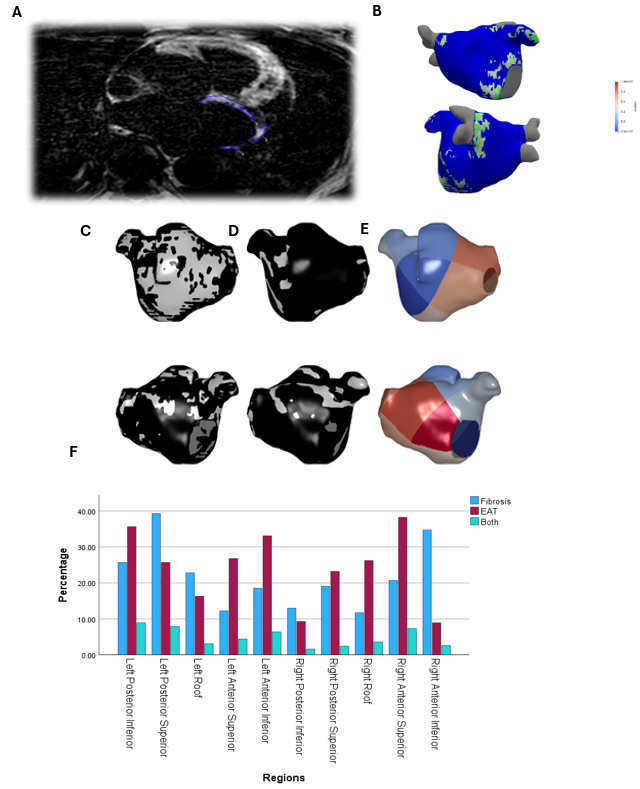Final ID: Sa2111
Regional Distribution and Overlap of Left Atrial Epicardial Adipose Tissue and Fibrosis
Abstract Body (Do not enter title and authors here): Background
Left atrial epicardial adipose tissue (LA-EAT) and fibrosis are implicated in the pathophysiology of the atrial fibrillation (AF) substrate.
Hypothesis
The distribution of fibrosis and LA-EAT differs across various regions of the LA.
Aims
Ascertain whether high fibrosis regions coincide with high EAT regions.
Identify specific anatomical regions in which LA-EAT and fibrosis tend to co-localize.
Methods
LA-EAT was imaged using MRI Dixon sequences and images were segmented axially using the software contouring tools. LGE-MRI was used for LA fibrosis quantification and segmentation. The regions of fibrosis and fat were then co-registered with the atrial geometry and projected onto the left atrial shell. A universal atrial coordinates (UAC) approach was then used to systematically delineate anatomical LA regions in a manner independent of inter-individual variabilities in scale and shape. Specifically, the LA was divided into 10 regions (left and right versions of: posterior-inferior, posterior-superior, roof, anterior-superior, and anterior-inferior). Levene’s test and ANOVA were used to check for any statistically significant variability.
Results
Nineteen patients were recruited (94% male; median age 72[62-74]; BMI 32.1±6.3; LA volume index 71.0±21.5mL/m2).LA fibrosis was highest in the left posterior superior segment, right anterior inferior, and left posterior inferior (39.3±16.2%,34.7±26.8%, and 25.7±20.9% respectively;F=1.9,p=0.15). LA-EAT was most prominent in the right anterior superior, left posterior inferior, and left anterior inferior segments (38.1±25.3%,35.6±18.4%,and 33.1±18.9% respectively; F=0.94, p= 0.39). Spatial co-localization of fat and fibrosis was highest in the left posterior inferior region (8.95±2.1%), followed by the left posterior superior, right anterior superior, and left anterior inferior region (7.9±2.1%,7.2±1.7%,and 6.3±1.6% respectively; F= 0.29, p=0.83 ).
Conclusion
LA fibrosis and EAT have differing regional preponderances, impacting the AF substrate through infiltrative and paracrine effects. This fibro-fatty remodeling creates structural and conduction abnormalities, forming stable reentrant circuits and perpetuating AF by providing varied pathways and refractory periods.
Left atrial epicardial adipose tissue (LA-EAT) and fibrosis are implicated in the pathophysiology of the atrial fibrillation (AF) substrate.
Hypothesis
The distribution of fibrosis and LA-EAT differs across various regions of the LA.
Aims
Ascertain whether high fibrosis regions coincide with high EAT regions.
Identify specific anatomical regions in which LA-EAT and fibrosis tend to co-localize.
Methods
LA-EAT was imaged using MRI Dixon sequences and images were segmented axially using the software contouring tools. LGE-MRI was used for LA fibrosis quantification and segmentation. The regions of fibrosis and fat were then co-registered with the atrial geometry and projected onto the left atrial shell. A universal atrial coordinates (UAC) approach was then used to systematically delineate anatomical LA regions in a manner independent of inter-individual variabilities in scale and shape. Specifically, the LA was divided into 10 regions (left and right versions of: posterior-inferior, posterior-superior, roof, anterior-superior, and anterior-inferior). Levene’s test and ANOVA were used to check for any statistically significant variability.
Results
Nineteen patients were recruited (94% male; median age 72[62-74]; BMI 32.1±6.3; LA volume index 71.0±21.5mL/m2).LA fibrosis was highest in the left posterior superior segment, right anterior inferior, and left posterior inferior (39.3±16.2%,34.7±26.8%, and 25.7±20.9% respectively;F=1.9,p=0.15). LA-EAT was most prominent in the right anterior superior, left posterior inferior, and left anterior inferior segments (38.1±25.3%,35.6±18.4%,and 33.1±18.9% respectively; F=0.94, p= 0.39). Spatial co-localization of fat and fibrosis was highest in the left posterior inferior region (8.95±2.1%), followed by the left posterior superior, right anterior superior, and left anterior inferior region (7.9±2.1%,7.2±1.7%,and 6.3±1.6% respectively; F= 0.29, p=0.83 ).
Conclusion
LA fibrosis and EAT have differing regional preponderances, impacting the AF substrate through infiltrative and paracrine effects. This fibro-fatty remodeling creates structural and conduction abnormalities, forming stable reentrant circuits and perpetuating AF by providing varied pathways and refractory periods.
More abstracts on this topic:
Artificial Intelligence Can Match Atrial Fibrillation Electrograms to Action Potential Recordings in Patients
Abad Juan Ricardo Carlos, Anbazhakan Suhaas, Ruiperez-campillo Samuel, Rodrigo Miguel, Narayan Sanjiv
Cardiorenal Interaction Assessment via ECG Features: A Study using Dynamic Time Warping and Extracted Feature ClusteringZhao Sally, Adhin Bhavna, Zhan Ye, Fisch Sudeshna

